Regardless of Google being on the twelfth era of its ubiquitous cellular OS, not too long ago it’s felt like Android has left tablets behind. Hell, even Google gave up making its personal tablets years in the past, whereas another gadget makers started favoring Chrome OS over Android on bigger gaadgets. However with Android 12L, Google is attempting to deal with a number of the OS’s shortcomings whereas additionally paving the best way for rising varieties of devices like foldables.
Why Android 12L?
In distinction to Google’s typical once-a-year launch cadence, Android 12L is a well timed callback to older variations of Android that bought one (or extra) mid-cycle updates. One large benefit of Android 12L is that as a result of Google doesn’t have to fret about together with bigger overarching adjustments because it does with its large yearly replace, the corporate will be extra focused about what sort of options ought to (or mustn’t) be included.
Who’s it for?
Sam Rutherford/Engadget
Google says Android 12L is a particular replace primarily meant to help larger-screen units, although all the brand new options will nonetheless make their manner into Android as an entire. At the moment, Android 12L will be put in on a variety of Pixel telephones (the Pixel 3 and up, however not the Pixel 6 or 6 Professional but), Google’s Android Emulator, and critically, Lenovo’s P12 Professional pill–which is the one pill and third-party gadget that’s been formally accredited to run Android 12L to date. (It’s additionally the principle gadget I’ve been utilizing to check 12L.)
When will Android 12L be prepared for launch?
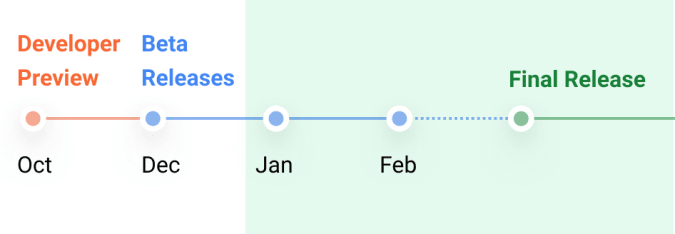
Proper now, Google is mid-way by way of its testing and growth cycle. Android 12L has already gotten two beta releases to this point (relying on the gadget), with a 3rd beta deliberate for someday later this month previous to an eventual launch someday by the top of Q1 2022 (which ends in March).
The massive adjustments in Android 12L
A brand new taskbar and improved multitasking
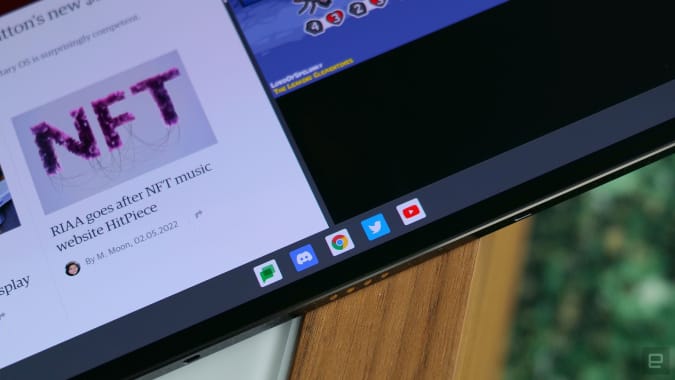
Sam Rutherford/Engadget
An important addition in Android 12L is the brand new taskbar. Just like taskbars on desktop OSes, Android 12L’s taskbar sits on the backside of the display and holds a collection of apps for straightforward entry (although I ought to word that on smaller units like telephones, the taskbar will not be there by default).
Not like many Android launchers, the taskbar is pinned in place, so it’ll all the time be there except you’re enjoying a fullscreen video or sport. That mentioned, you can also make it disappear whenever you need by urgent and holding. However the place issues get actually fascinating is that you may additionally open up apps straight into split-screen mode just by dragging the app icon up from the taskbar into the center of your display. From there, you may simply modify the scale of the app’s window nonetheless you need.
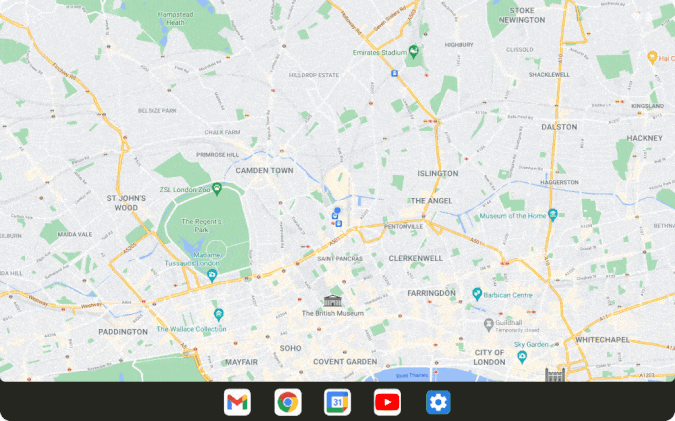
This far into Android’s growth cycle, the addition of a taskbar and the power to pull and drop apps into split-screen mode is as near a “game-changer” as we’re going to get. It makes the method of multitasking a lot quicker and simpler—notably for bigger units like tablets and smartphones which regularly really feel like they’ve extra display actual property than they will really make the most of.
That mentioned, there are some essential limitations as a result of not like Samsung’s One UI, there isn’t a straightforward option to open up three apps in split-screen on the identical time or create everlasting app pairs. However much more than that, the taskbar maxes out at 5 apps, which feels a bit restricted. I imply simply take a look at all the additional room on the left and proper the place extra apps may go. I’m actually hoping that for the ultimate construct, Google will increase the variety of apps that may reside down there, particularly when present foldables just like the Samsung’s Galaxy Z Fold3 have an analogous taskbar that helps as much as eight icons (plus a launcher) with ease.
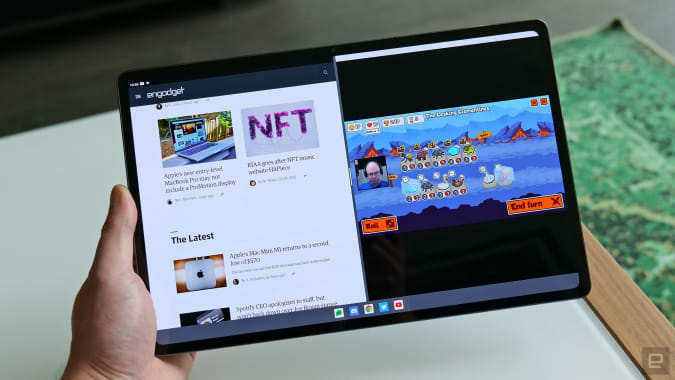
Sam Rutherford/Engadget
For individuals who like to observe movies, Google not too long ago added a brand new split-screen icon to the second Android 12L beta’s picture-in-picture mode, so you may extra simply go from the mini participant to multitasking with only a couple faucets.
UI enhancements
The opposite large space of enchancment in Android 12L are adjustments to the OS’s UI for bigger screens. So as an alternative of the single-column notification tray we’re used to seeing on telephones, Android 12L incorporates a two-column format that places notifications on the correct alongside your common fast settings icons on the left. It’s an easy change, nevertheless it actually does make the additional show space on greater units really feel extra worthwhile. And it’s an analogous scenario for the Settings menu, although as soon as once more I ought to level out that Samsung’s OneUI has had this for a while on bigger foldables. Sadly on the P12 Professional, I seen that the two-column notification format solely works in panorama mode, which hopefully Google can handle in a future replace.
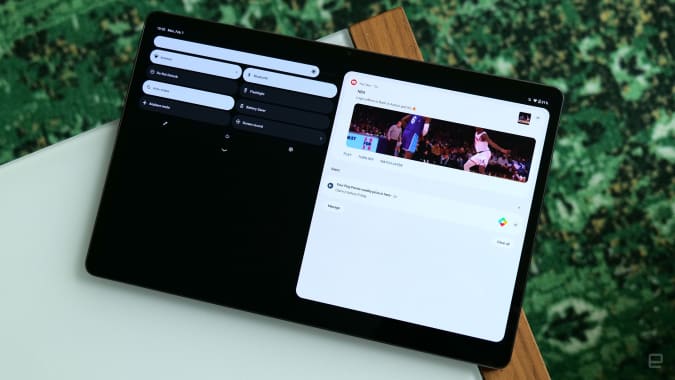
Sam Rutherford/Engadget
One other intelligent quality-of-life replace is the power for Android 12L to maneuver the PIN or pattern-entry menu on a tool’s lock display to left or proper, primarily based on the place you most not too long ago touched the display. It makes stepping into your gadget only a bit quicker and simpler. Although as soon as once more, Google nonetheless must tweak issues a bit. On the P12 Professional, the sphere exhibiting your pin seems on the prime of the display, which seems a bit awkward (and likewise fairly hilarious) in portrait mode. Google additionally up to date the Latest Apps display with a brand new format that retains the prevailing card-based system whereas higher using the area on the edges of your show.
Lastly, whereas it’s not out there on the P12 Professional simply but, Google additionally added a brand new “double line” clock choice to the lock display. So as an alternative of getting an enormous clock smack dab in the course of your show, you may select a extra compact timepiece that’s tucked up within the prime left nook.
Much more under-the-hood large display optimizations
Elsewhere, Android 12L has much more refined enhancements designed to make apps look higher on greater screens, even when these apps haven’t been up to date shortly. For apps that haven’t been already optimized by their builders, Google upgraded Android 12L’s compatibility mode to make apps robotically look and reply higher throughout numerous display resolutions and orientations. And for apps that don’t take up all the display, Google added new letterboxing choices together with new overlays and background settings. There’s even a brand new device to use rounded corners to app home windows, although as you may see by the squared-off apps from our Android 12L check gadget, it’s as much as gadget makers to implement them as they see match.
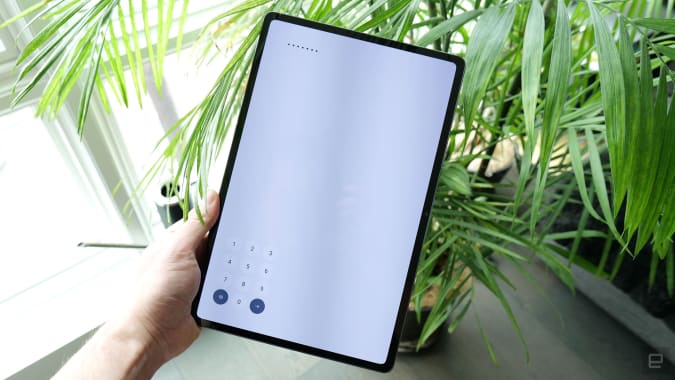
Sam Rutherford/Engadget
Sooner or later, Google will even add rankings to Play Retailer to assist level out which apps have been optimized for big display units and help issues like adaptive layouts and scaling choices, which is very essential for foldables that may swap between numerous display resolutions and side ratios on the fly.
Then there are extra area of interest adjustments like up to date M3 buttons (those that appear like little tablets) that ought to assist name consideration to essential permissions, some new animations (just like the one for energy in fast settings) and extra intuitive labels for essential multitasking features (like renaming “pin to prime” to “cut up prime”).
What Android 12L means for future units
Google has been very clear so far saying Android 12L is meant to help “the following wave of Android 12 tablets, Chromebooks and foldables.” So whereas you might even see some enhancements on telephones, Android 12L is basically setting the desk for the following batch of big-screen cellular units. Nevertheless, if we’re studying between the traces, maybe the larger takeaway is that Android 12L may herald the arrival of the long-rumored Pixel Fold or probably the return of a first-party Google pill. Google hasn’t achieved a mid-cycle Android replace since Android 8.1 in late 2017, which suggests Google might need some upcoming {hardware} designed to essentially showcase all the brand new options in Android 12L.
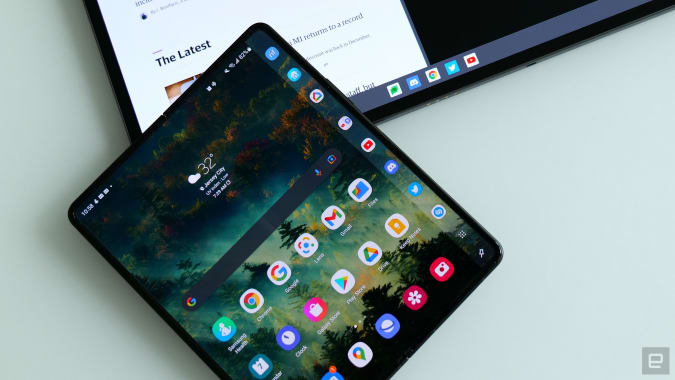
Sam Rutherford/Engadget
However has it labored? In comparison with vanilla Android 12, the brand new taskbar in Android 12L makes a right away affect on how you utilize and multitask on a pill or different large display gadget. With so many individuals working and studying from house, the times when a pill may very well be a easy video watching or social media machine are over, and with Android 12L is Google acknowledging that shift.
Nevertheless, it isn’t a transparent win, as a result of when in comparison with Chrome OS which already has a devoted taskbar and the power to run Android apps, Chrome OS-based units usually really feel like they’re higher suited to deal with on a regular basis productiveness or training wants, notably on devices with built-in or elective keyboards. However for mobile-first hybrid units like foldables, Android 12L makes plenty of sense, even when many of those new options are already out there in different variations of Android like One UI.
All merchandise advisable by Engadget are chosen by our editorial crew, unbiased of our father or mother firm. A few of our tales embrace affiliate hyperlinks. If you happen to purchase one thing by way of certainly one of these hyperlinks, we might earn an affiliate fee.


